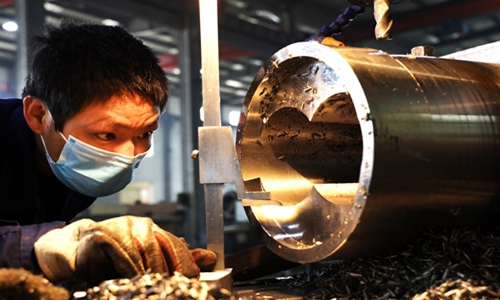China's manufacturing sector faces contraction
Factories struggle to recover as consumers’ demand dive

A worker at a factory in Zhoushan, East China's Zhejiang Province, produces a molding machine screw. Currently, many enterprises and factories nationwide have resumed production, while carefully ensuring containment of the CODIV-19 spreading. Photo: cnsphoto
Activity in China's factory sector is expected to contract in February due to the fallout of the coronavirus outbreak on the world's factory, according to market observers.
The purchasing managers' index (PMI) for the manufacturing sector is estimated to fall considerably below 50, the demarcation between expansion and contraction, Wu Jinduo, head of fixed income at the research institute of Great Wall Securities, told the Global Times on Wednesday.
The National Bureau of Statistics (NBS) is scheduled to release the PMI reading for February over the weekend.
The official PMI reading edged down 0.2 points to 50 in January while the official non-manufacturing PMI hit 54.1, up 0.6 points from the prior month.
Wu cited this year's Spring Festival holiday, which was extended well into February due to the COVID-19 epidemic, and delayed resumption of work and transportation across the country.
The economies of the four first-tier cities - Beijing, Shanghai, Shenzhen and Guangzhou - are gradually rebooting. But considering the risk of epidemic resurgence and the spread of the virus back into the country from overseas markets, a majority of Chinese factories were very much subdued in production, according to Wu.
A handful of high-frequency indicators across different sectors tracked by Goldman Sachs also point to the virus' damping impact on the Chinese economy.
While new confirmed infections over the past few days are declining now, "railway-loaded coal volume over the past week remains 25 percent lower than the average level in the past three years," the investment bank said in a note circulated to the Global Times on Wednesday.
Daily coal consumption of major electricity producers has seen a slight increase, albeit well below the normal level. Additionally, steel demand in the third week after the Spring Festival holiday was roughly 50 percent of the normal level seen over the past three years, Goldman Sachs said.
Particularly worth noting is that Wuhan city in Central China's Hubei Province, the epicenter of the deadly virus, is a major global base for auto parts suppliers and assembly lines. The city, known as China's Optics Valley, is also home to many high-tech manufacturers.
It is fairly difficult or too costly for other parts of the country or the rest of the world to replace the functionality of these sectors in Wuhan, remarked Wu at Great Wall Securities.
Data from the China Association of Automobile Manufacturers showed on Wednesday that 1.77 million vehicles were produced in January, down 25.4 percent year-on-year while auto sales shrank 18.7 percent to 1.93 million.
Although the fallout of the virus outbreak on the nation's auto sector was already evident in January, it is expected that its impact would be fully shown in February, the association said, forecasting a deeper fall in both auto production and sales.
In a research note sent to the Global Times on Wednesday, Mark Zandi, chief economist at Moody's Analytics, wrote that "shuttered Chinese factories are also a problem for countries and companies fastened into China's manufacturing supply chain," citing Apple, Nike and General Motors as some prominent American examples.
"Shortages of some goods will likely result this spring, meaning higher prices for things we buy at Walmart and on Amazon," according to Zandi.



